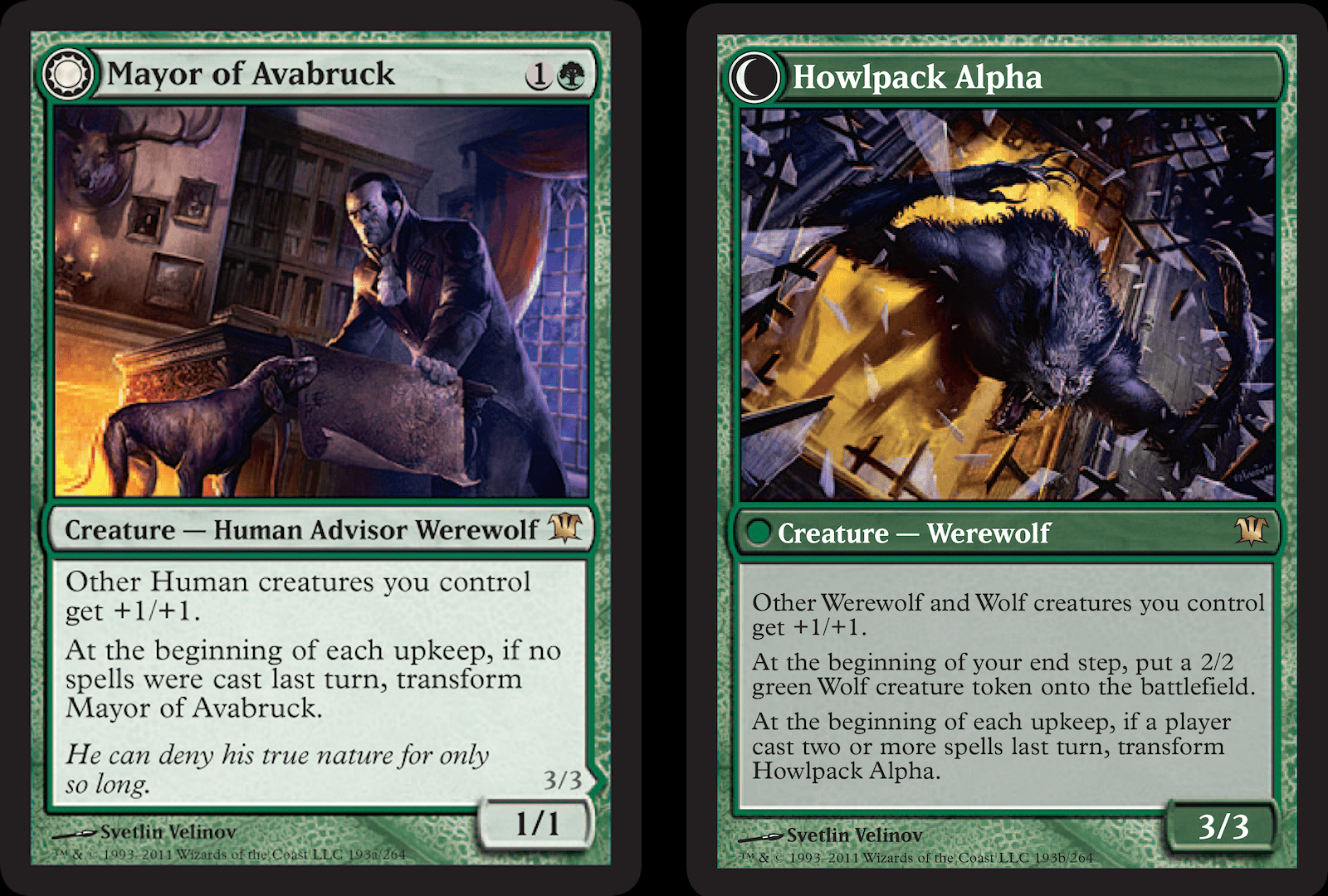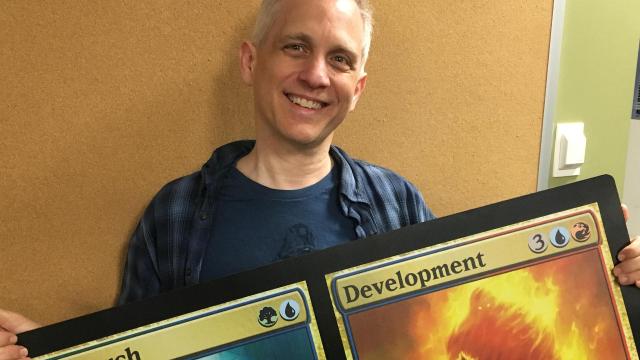“Magic is secretly, not really… it’s not one game,” head Magic: The Gathering designer Mark Rosewater told me. “It is actually a bunch of different games that all have a shared rule system. Every time I make a card set, I’m making the game for everybody, but for each person, it’s a different game to them.”
Photo courtesy Wizards of the Coast
Designing Magic to be playable by both professionals and casual groups of friends is one of the numerous design challenges Rosewater confronts on a daily basis. As a Magic designer for 21 years, and head designer for the last 14, Rosewater is one of the main reasons the game is surging in popularity, and why it has stayed relevant while nearly every other collectable card game launched in its wake has since collapsed. Rosewater might just be the best game designer in the world.
“Richard Garfield was the creator of the game,” Rosewater responded when asked about the game’s staying power. “[Garfield] talked about Magic being a game that’s bigger than the box. The idea being that most games, when you sit down to play the game — take Monopoly as an example — like, you know what you’re going to get. Because every time you play Monopoly, it’s the same pieces. You’re not going to be surprised. It’s the same board with the same 40 squares. … But Magic doesn’t do that. Magic, each person, what they have of the game is different. And that part of what makes the game the game is that aspect of exploration.”
While it’s easy to speak of Magic as an open and exploratory experience in the abstract, it’s far more difficult to design gameplay to ensure it. One of the terms that comes up with an almost mantra-like frequency throughout Rosewater’s design process is elegance: Finding the simplest and cleanest way to do something. “As Magic adds things to it, if we’re not careful, we may get farther and farther away from the base level person who has never played before,” he said. “And so a really big part of trying to make Magic is figuring out how to find… the depth in the simplicity. How do I make nice, simple, clean things that people can understand, but when you add it all together, it’s something that there’s depth to?”
As Magic matures and grows — almost 17,000 cards have been released in the game’s 24-year history — repeating card mechanics or even functionally reprinting classic cards from older sets simultaneously creates a nostalgia for the early days, while serving as guideposts for newer players to steep themselves in the history of the game. “We have to be willing to embrace simple things that we’ve done before,” Rosewater said. In this way, repetition serves to both ensure discoveries for players new to the game, and keeps existing players invested, allowing them to use old and known cards in new ways.
Of course, a game would get boring and predictable if it simply rehashed well-worn cards from the past. In an effort to keep finding new space to explore and keep an ever-growing player base guessing, Rosewater was adamant that risk taking was an essential skill for the design team. He brought up one of the chief mechanics from the set Innistrad — doubled-faced cards, which had another card on the back instead of the regular card backs every previous set had — as a choice to venture into uncharted territory.
“Magic, for many, many years, you know, it had one face,” said Rosewater. “The back was always the back. And then one day we said, ‘Whoa, what if that wasn’t true?’ And we were able to make a whole bunch of new cards because we’d never mined that space before. And that’s something we might not have been willing to do 10 years ago. But five years ago, we were.” Many tournament-winning decks incorporated these cards, and they were also flavorful and evocative of the gothic horror setting of Innistrad, which is more important than it might seem.
Another of Rosewater’s design principles is resonance: Beyond finding new and flashy things for cards to do, there must be contextual clues and reasons for doing them. The double-faced cards introduced in Innistrad changed based on an in-game event; werewolves flip from human to wolf depending on whether it is night or day, for example. It is easy for a player to grasp the how and the why, and subsequently easier to understand the in-game ramifications of the newer card. Rosewater used the mechanic of flying — creatures with flying can only be blocked by other creatures with flying — to make this point.

A double-backed card from Innistrad. Images courtesy Wizards of the Coast
“If I wanted to teach you flying, the reason that’s easier to teach you than most mechanics is it just does what you think flying would do,” he explained, before coyly revealing some of the resonant ideas from Amonkhet, a soon-to-be-released set with Ancient Egyptian undertones. “What would people expect to be in an Egyptian-themed set? Mummies? Yeah! Let’s have mummies. Pyramids? Let’s have some pyramids!” These touchstones not only inform the mechanics of the set, but also the overall flavour and stylistic decisions that help players understand the constant amount of new information being thrown at them.
In constantly devising new mechanics, the biggest pitfall Rosewater and the designers must avoid is power creep, the game design equivalent of the disease of more, when the need to create evermore cards results in newer cards being more powerful than older ones, throwing off the delicate balance of the game as a whole. To avoid power creep, Rosewater attempts to design the game as an M.C. Escher stairway. “Is there a way to create the illusion that the game is always getting more powerful, when in reality we’re not changing the power level?” Rosewater asked, before continuing. “So the secret is, what you do is you change some things, and you put a focus on the things you’re changing, and then meanwhile, other things you depower.”
It’s a delicate operation, and one that doesn’t always work out. Sometimes it is a single card at issue, like the legendary creature Emrakul, the Promised End, which was showing up in nearly every tournament deck at the end of 2016. Sometimes, it is an entire new mechanic, like affinity during the mid-2000s. The most extreme tool to rebalance the game is to ban or restrict certain cards, essentially admitting that the designers made a major error. (Emrakul, the Promised End was banned in January). Powerful cards, like all cards, also eventually rotate out of functionality as the most popular tournament format — known as Standard — only allows decks constructed with the last two years of cards.
But while the design team has an obviously huge role in shaping Magic, so to do its players and the culture writ large. “We went from gaming as a thing that some people do to gaming is a thing people do,” said Rosewater. “And the way that I try to talk about it is, movies went from a similar procedure where, early in movies’ life, certain people would go to movies, but it was a special thing like, you were a movie enthusiast. And then at some point it just became a thing. Like it’s not who goes to movies, everybody goes to the movies.”
Rosewater was also quick to point out that computers, phones and the internet — which allow for more widespread gameplay — are also extremely helpful in terms of allowing him to interact with players, and see how his designs are being used in the real world. “Richard’s original vision was, it’s a secret,” Rosewater remarked with a chuckle. “We’re not going to tell anybody. You have to explore. We’re not going to share the card lists, we’re not going to tell you anything. You have to find out by going and playing other people.”
Now, of course, there is an entire online industry devoted to covering tournaments and analysing cards, with articles on theory and technical play a mouse click away. But competitive play is just one subset of the Magic fanbase, a split into niche interests Rosewater finds beneficial. “It used to be, ‘I’m a Magic player,’ or, ‘I’m not a Magic player,’” he said. “Now it’s like, ‘I’m a Magic player.’ Well, what kind of Magic player? What format do you play? What about Magic do you enjoy?”
Which brings Rosewater to his description of Magic as different games with a shared rule system. “To some people it’s a competitive game about playing, you know, the last two years of cards and going to tournaments,” he said. “And other people it’s about sitting with their friends at the kitchen table playing a 100-card commander deck. For other people it’s like playing cards from way, way long ago and doing crazy things that are so way powerful that we could never do them again. Different people want different things out of the game, and so one of the challenges of designing the game is designing it such that I make something for everybody.”
This need to serve a diverse player base is a design challenge, but also Magic’s greatest strength, and what Rosewater attributes much of its success too. “I’m a biased person, but Magic to me is the best game ever made. It is an awesome, awesome game,” he said. “And it is a game that does something that very few games do, which is, it lets you be the game designer.” Every year hundreds of new cards are released, unleashing untold deck-building possibilities. But as those decks are being built, the design team has already moved on to the next set.
Rosewater is excited for the challenge. “This year, in October, I will have been here 22 years,” he said, with a noticeable amount of pride. “And people always say to me, ‘Well don’t you get bored? Don’t you get bored doing the same thing?’ And I’m like, ‘I’m not doing the same thing. Every year I’m making a brand-new game that I’ve never made before for a wider group of audiences that want lots of different things.’”
“It is not boring. It’s challenging, but it is never boring.”

Comments
2 responses to “Magic: The Gathering’s Head Designer Has A Damn Hard Job”
Rosewater is a really cool guy. He’s constantly learning and constantly teaching what he’s learned. He’s been a big influence for several renowned game designers today.
Rosewater is a pretty cool dude. But that voice. I remember first hearing it during an interview about Khans of Tarkir and just… cringing. I couldn’t get through the video.
Seriously, it’s like something from Revenge of the Nerds.